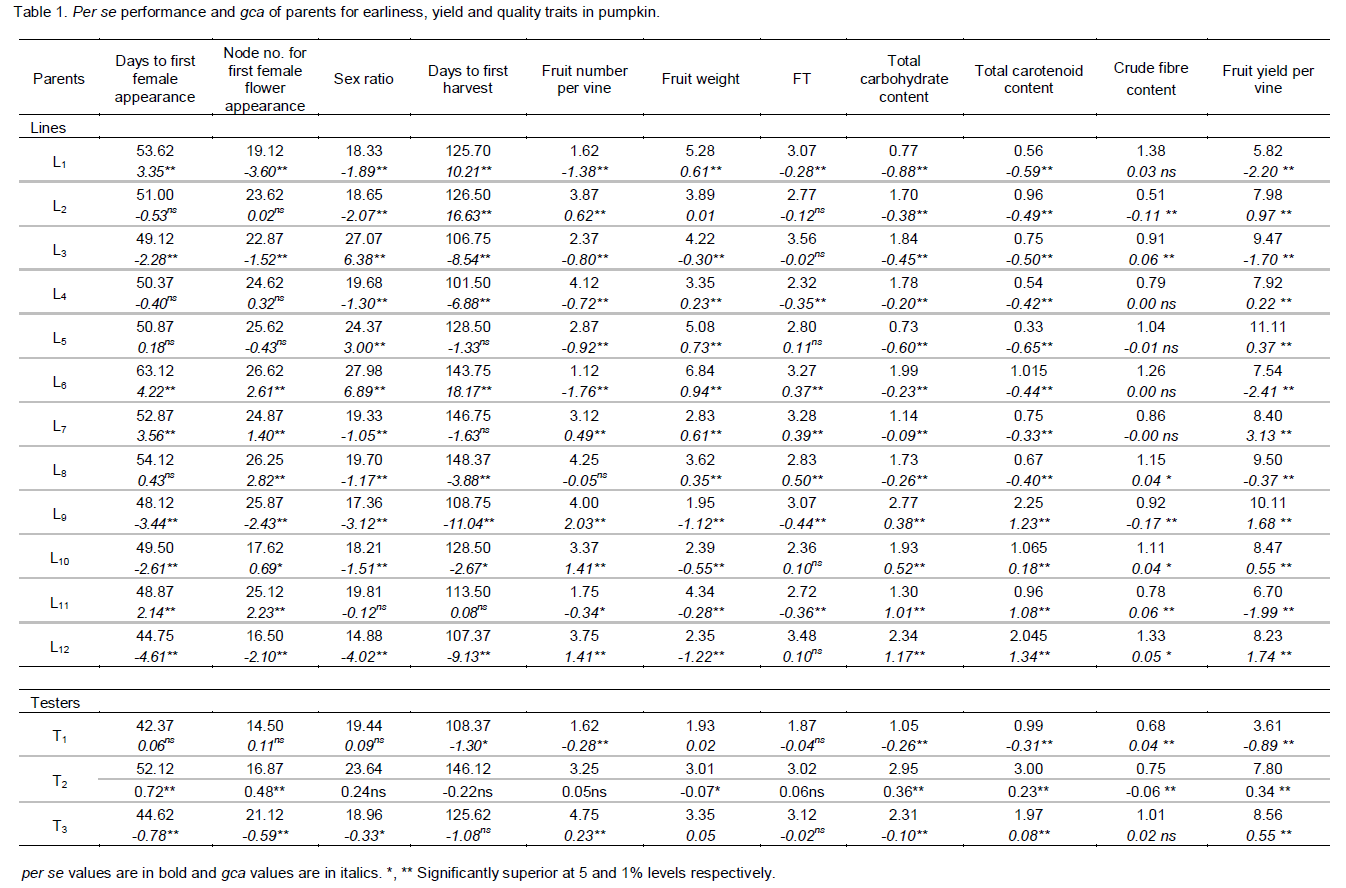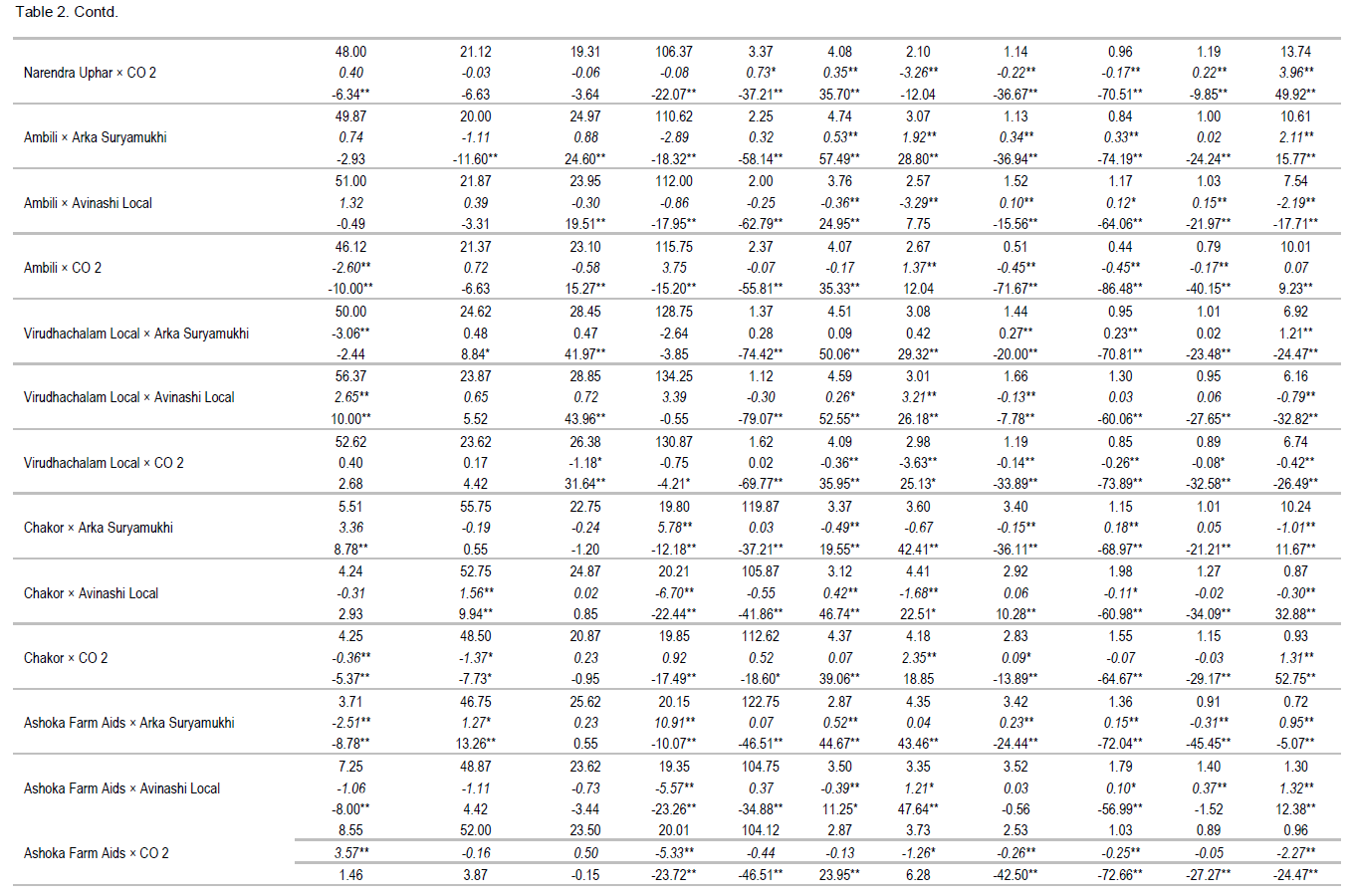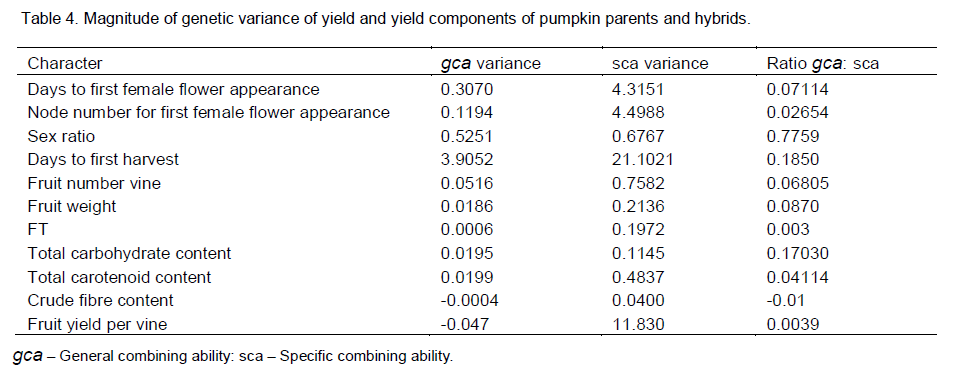Pumpkin (Cucurbita moschata Duch ex.Poir) originated from Central Mexico is cultivated in tropical and subtropical region all over the world and an important cucurbitaceous vegetable crop of India and principal ingredient of several Indian dishes (Mohanty and Mohanty, 1998). In India, it occupies an area of 11,060 ha with an annual production of 2, 77,560 tonnes accounting to an average productivity of 25.10 t/ha (Anon, 2012). Pumpkin is consumed as culinary vegetable at immature and mature fruit stage. It provides a valuable source of carotenoid and ascorbic acids that have a major role in nutrition in the form of pro-vitamin A and vitamin C as antioxidants (Jha et al., 2009). Its big size seeds contain appreciable quantities of protein and oil. It may serve as good substitute for edible oil, similar to that of oil of summer squash (Cucurbita pepo). Therefore, pumpkin as vegetable is becoming important ingredient in daily diet, but relatively little attention has been paid towards development of hybrids/varieties rich in carotenoids with high yielding capacity.
Though a wide range of variability is encountered in this crop, very little attention has been paid to exploit it in breeding programmes. A thorough knowledge about the genetic behaviour of a character is important in formulating appropriate breeding technique in a crop. The monoecious character, conspicuous and solitary flowers, large seed number per fruit and wide variability for yield, size and shape of fruit make this crop congenial for commercial breeding. During the last two decades many workers utilized heterosis breeding as a tool for improvement of yield in pumpkin (Sirohi and Ghorui, 1993). However, the genetic potential of this crop needs further exploitation to its nearest perfection. Hence the present investigation was undertaken to determine the magnitude of heterosis for earliness and yield parameters in pumpkin.
Choice of parents considered as an important aspect in any breeding programme aimed to improve the yield and its related attributes. The success of hybridization programme is generally depends upon the breeder to select suitable parents to obtain high proportion of desirable recombination. One of the possible approaches for achieving the targeted production is to identify and develop suitable hybrids with high yield and good quality. The exploitation of heterosis is much easier in cross pollinated crops and pumpkin being monoecious crop, provides ample scope for the utilization of hybrid vigour on commercial scale.
Further, the diversified parents from different locations with high yield and quality would also pave way for the development and release of hybrids through heterosis breeding. The hybrid vigour is substantially increased on crossing genetically diverse inbreds and thus heterosis mostly obtained from genetic diversity among the parents involved (Sharma, 1994).
Line x tester analysis helps in the selection of desirable parents and also appropriate breeding procedure by measuring general combining ability (gca), specific combining ability (sca) variances and their effects and the genetic components of variance (Singh and Narayanan, 1993).The concept of combining ability helps the breeder to determine the nature of gene action involved in the expression of quantitative traits of economic importance.
The experimental material comprised fifteen diverse genotypes including twelve lines viz., Pusa Vishwas (L1), Punjab Samrat (L2), Narendra Abhushan (L3), Narendra Uphar (L4), Ambili(L5), Virudhachalam Local (L6), Chakor (L7), Ashoka Farm Aids (L8), Vadhalagundu Local (L9), Karamadai Local (L10), Karwar Local (L11) and Kasi Harit (L12) and three testers viz., Arka Suryamukhi (T1), Avinashi Local (T2), CO 2 (T3) and they were crossed in line x tester mating design to obtain thirty six hybrids. The fifteen parents and thirty six F1 hybrids were evaluated along with the standard check “hybrid MPH-1” (Mahyco Hybrid Seeds Private Limited) in randomized block design (RBD) with three replications at Department of Vegetable Crops, Tamil Nadu Agriculture University, Coimbatore - 641103 during 2009-10.The seeds of the experimental material was planted in an inter row spacing of 2.5 m and intra row spacing of 2.5 m apart. There were five plants per plot per replication with a total of 780 plants maintained. Observations were recorded on traits viz. days to first female flower appearance, node number to first female flower appearance, sex ratio (Female flowers / Male flowers), days to first harvest, fruit number per vine, fruit weight, flesh thickness (FT) and fruit yield per vine quality traits viz.,Total carbohydrate content, total carotenoids content and crude fibre content. Total carbohydrate content of fruit was estimated at harvestable maturity with the anthrone method of Hedge and Hofreiter (1962). Total carotenoid content of fruit flesh was estimated using the method of Roy (1973) and crude fibre estimation by the method suggested by Chopra and Kanwar (1976) and expressed as per cent.
The mean values were utilized for statistical analysis. Heterosis in F1 hybrids was estimated for each trait based on all the criteria using three mean values (Gowen, 1952). Estimation of general and specific combining ability analysis was done using the line x tester method described by Kempthrone (1957).
Estimation of combining ability effects
Both the gca and sca effects of an ijkth observation was derived by using the mathematical model given below
The general combining ability effect of parents and specific combining ability effect of hybrid combinations were estimated as follows.
gca effects of lines
Where,
x … = Total of hybrids over ‘r’ number of replication
xi.. = Total of ith line over ‘t’ testers and ‘r’ replications
x.j. = Total of jth tester over ‘l’ lines and ‘r’ replications
sxij. = Total of the hybrids between ith line and jth tester over ‘r’ replications.
In any crop breeding programme, it is essential to eliminate the undesirable types, which can be achieved by studying the per se performance of parents and hybrids. The choice of parents become easy when a trait is unidirectionally controlled by a set of alleles and additive effects are prominent, since they can be chosen on the basis of per se performance. The per se performance and gca effects of the parents are presented in Table 1. Among the twelve lines and three testers evaluated, Vadhalagundu Local (L9) was the best as it expressed good performance for yield, seven yield contributing characters viz., days to first female flower appearance, sex ratio, days to first harvest, fruit number per vine and total carbohydrate content and total carotenoids content. It was followed by the line Kasi Harit (L12) which possessed good performance for yield, yield contributing traits viz., days to first female flower appearance, node number for first female flower appearance, sex ratio, days to first harvest, and fruit number per vine, quality trait viz.,Total carbohydrate content and total carotenoid content (Table 1).
Among the testers, CO 2 (T3) ranked first as it registered superior per se performance for days to first female flower appearance, sex ratio, days to first harvest, fruit number per vine, fruit weight and fruit yield per vine and quality characters like total carbohydrate content and crude fibre content. This was followed by the tester Avinashi Local (T2) exhibiting superiority for node number for first female flower appearance, fruit weight, FT, total carbohydrate content and total carotenoids content. However, selection of parents based on per se performance alone might not hold promise in producing superior hybrids.
In majority of the cases, parents with high mean performance were found to show significant gca effect and this was in conformity to the report of Lawande and Patil (1990) and Sundaram (2006) in bitter gourd. In the present investigation, the combining ability for each character was analysed (Table 1). The line Vadhalagundu Local (L9) recorded significant gca effects for twelve traits viz., days to first female flower appearance, node number for first female flower appearance, sex ratio, days to first harvest, fruit number per vine, total carbohydrate content, total carotenoid content and yield. This was followed by the line Kasi Harit (L12) which was the best combiner for days to first female flower appearance, node number for first female flower appearance , sex ratio, days to first harvest, fruit number per vine , total carbohydrate content, total carotenoid content, and yield per vine. Among testers, CO 2 (T3) had significantly high gca effect for days to first female flower appearance, node number for first female flower appearance, fruit number per vine, total carotenoid content and yield per vine. The tester Avinashi Local (T2) could also be used to develop hybrids with total carbohydrate content , total carotenoid content and fruit yield per vine as by its significant higher gca value (Table 1).
As evaluation based on per se performance and combining ability effects separately did not show parallelism, it is therefore necessary to consider both per se and combining ability effects together for further isolation of desirable parental genotypes and hybrids. The per se performance and gca effects were related to each other in parents. According to Sharma and Chauhan (1985), the per se performance and gca effect of the parents were directly related to each other, will result in the selection of parents with good reservoir of superior genes. Majumder and Bhowal (1988) also reported the parallelism between per se performance and gca effect. Combining gca and per se, Kasi Harit (L12) was the best parent for days to first female flower appearance, node number for first female flower appearance, sex ratio, days to first harvest, total carotenoid content, total carbohydrate content, crude fibre content and yield. The parent Vadhalagundu Local (L9) had desirable performance for days to first female flower appearance, days to first harvest, sex ratio, fruit number per vine, total carbohydrate content and total carotenoid content and fruit yield per vine. Hence crosses involving Kasi Harit (L12) and Vadhalagundu Local (L9) would help in improvement of yield (Table 1).
The sca effect of hybrid is the deviation from the performance predicted based on the gca of the parents (Allard, 1960). The sca effect is due to dominance, epistasis and environmental influence. Under certain favourable conditions, all the non additive gene functions may get triggered and result in high sca effect and mean value of a responding hybrid. Thus evaluation of a hybrid for high per se and sca effect is also an important criterion. The per se, sca effect and standard heterosis values of 36 hybrids were given in Table 2.
Hybrids with high per se and sca effect were evaluated for selection of best hybrids. Evaluation of hybrids for per se and sca revealed that the cross Kasi Harit × Avinashi Local (L12 × T2) was adjudged as the best hybrid, since it recorded the highest mean and sca effect for more number of traits of study viz., earliness in terms of early female flowering, early node of female flower appearance, sex ratio fruit number per vine, FT, total carotenoid content and total yield per vine. The next best hybrid, Vadhalagundu Local × CO 2 (L9 × T3) could also be justified as the better combination through less node number for first female flower appearance, fruit number per vine, sex ratio, FT, total carotenoid content and fruit yield per vine (Table 2). Jha et al. (2009) endorsed the same results in pumpkin.






Evaluation of hybrids based on the three criteria viz., mean, sca and standard heterosis would lead to the identification of different sets of cross combinations for each of these criteria. However, the scope for exploitation of hybrid vigour in a heterosis breeding programme depends not only on the extent of heterosis for individual traits but also on the mean performance and sca effects of hybrids. Hence, it would be more appropriate to evaluate the hybrids based on all these criteria.
Such an evaluation had revealed that none of the hybrid was found to exhibit superiority for all the three criterions for all the characters under study. Evaluation based on per se performance, sca effects and standard heterosis had revealed that the hybrid Kasi Harit × Avinashi Local was adjudged as the best hybrid as it excelled in exhibiting its superiority on more number of traits viz., earliness in terms of days for first female appearance, sex ratio, days to first harvest, fruit numbers per vine, FT, quality trait like total carotenoid content besides yield per vine. Next to this hybrid, Vadhalagundu Local × CO 2 was adjudged as the next best one as the hybrid surpassed in per se, sca effect and heterosis for traits viz., earliness in terms of node number for first female flower appearance, sex ratio, fruit number per vine, FT, Total carotenoid content and fruit yield per vine (Table 2). Concomitant reports were also given by Vidya et al. (2002) in pumpkin.
Highly significant variances were observed for both general and specific combining ability for all the characters under study (Table 3). Findings indicated that parents and crosses differed significantly with regard to their general and specific combining ability, respectively. The ratio of gca / sca variance exhibited additive and non-additive gene action, for all traits (Table 4). The ratio of gca: sca variance indicated higher magnitude for sca variance than gca variance for the following characters viz., days to first female flower appearance, node number for first female flower appearance, sex ratio, days for first harvest, number of fruits per vine, fruit weight, total carotenoid content, total carbohydrate content, crude fibre content of the fruit and fruit yield per vine implying the preponderance of non-additive gene action (Table 5). This indicated the limited scope of population improvement for these characters and heterosis breeding could be adopted for exploiting the genetic variations. Similar results in respect of these characters were obtained by Srinivasan (2003) and Jha et al. (2009) in pumpkin.
The hybrids Kasi Harit × Avinashi Local and Vadhalagundu Local × CO 2 can be well exploited through heterosis breeding to obtain higher yield with quality fruits. Moreover, these hybrids could be better utilized for the improvement of the characters concerned and intermating among superior segregants resulting from these heterotic hybrids, is likely to throw desirable progenies in the subsequent later generations. On the basis of the above findings, it can be concluded that improvement in pumpkin for earliness and yield related characters would be brought out through hybridization (heterosis breeding).

